Business Operations Analysis: Functions, Accounting, and Teams
VerifiedAdded on 2020/12/09
|13
|3521
|442
Report
AI Summary
This report examines the key elements of business operations, encompassing various organizational aspects. It begins with an introduction to business plans, vision, and objectives, followed by an exploration of accounting's importance in recording financial transactions and evaluating performance. The report includes a profit and loss statement analysis, focusing on Marks and Spencer's performance over two years. It then delves into the stages of team development, leadership styles, and motivation theories like Maslow's and Mayo's, highlighting the impact of customer service and the benefits of customer profiling. The report also covers organizational structures and the roles of different departments within a company. The assignment provides a comprehensive overview of how businesses function, covering crucial elements such as team dynamics, accounting principles, and leadership strategies.
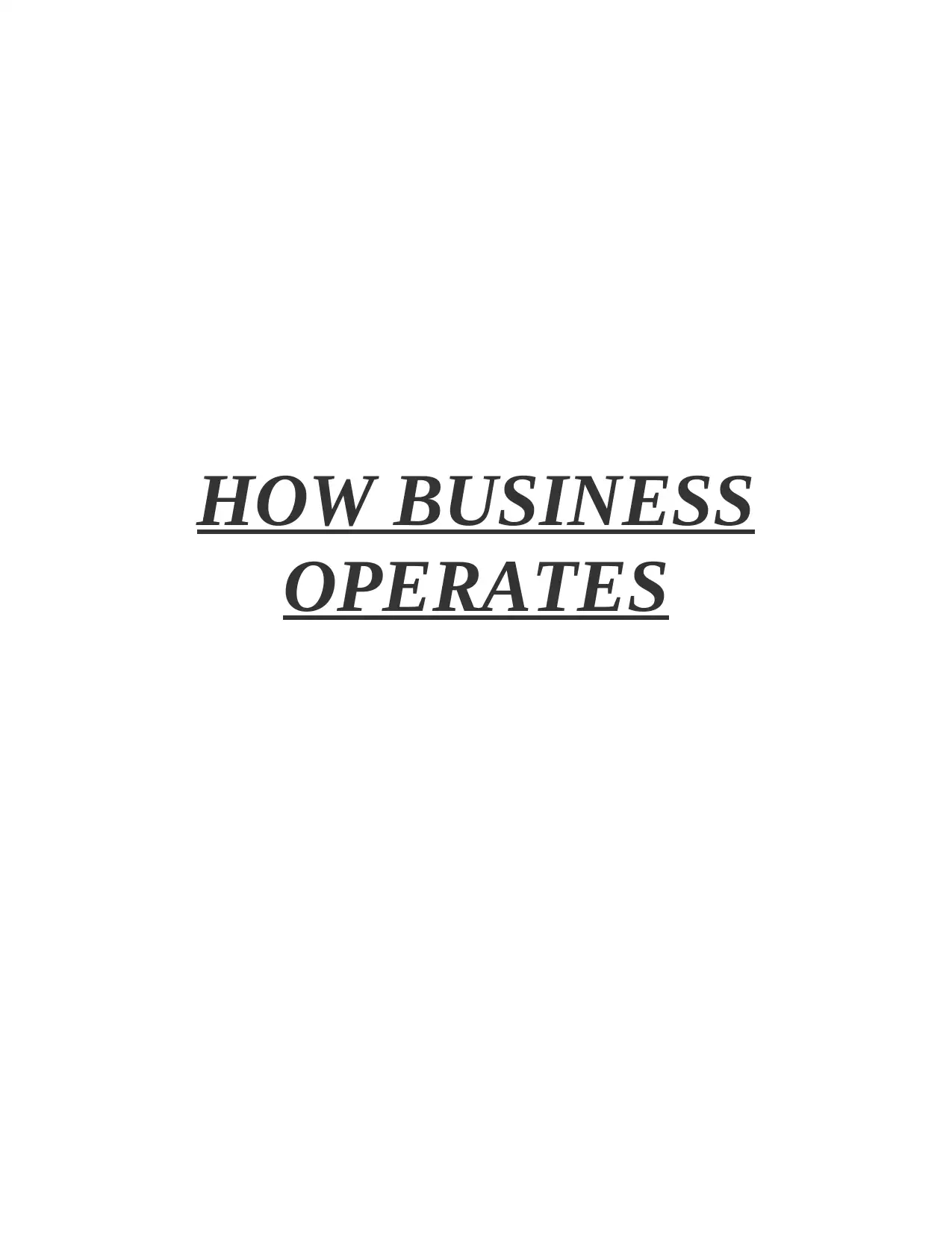
HOW BUSINESS
OPERATES
OPERATES
Paraphrase This Document
Need a fresh take? Get an instant paraphrase of this document with our AI Paraphraser
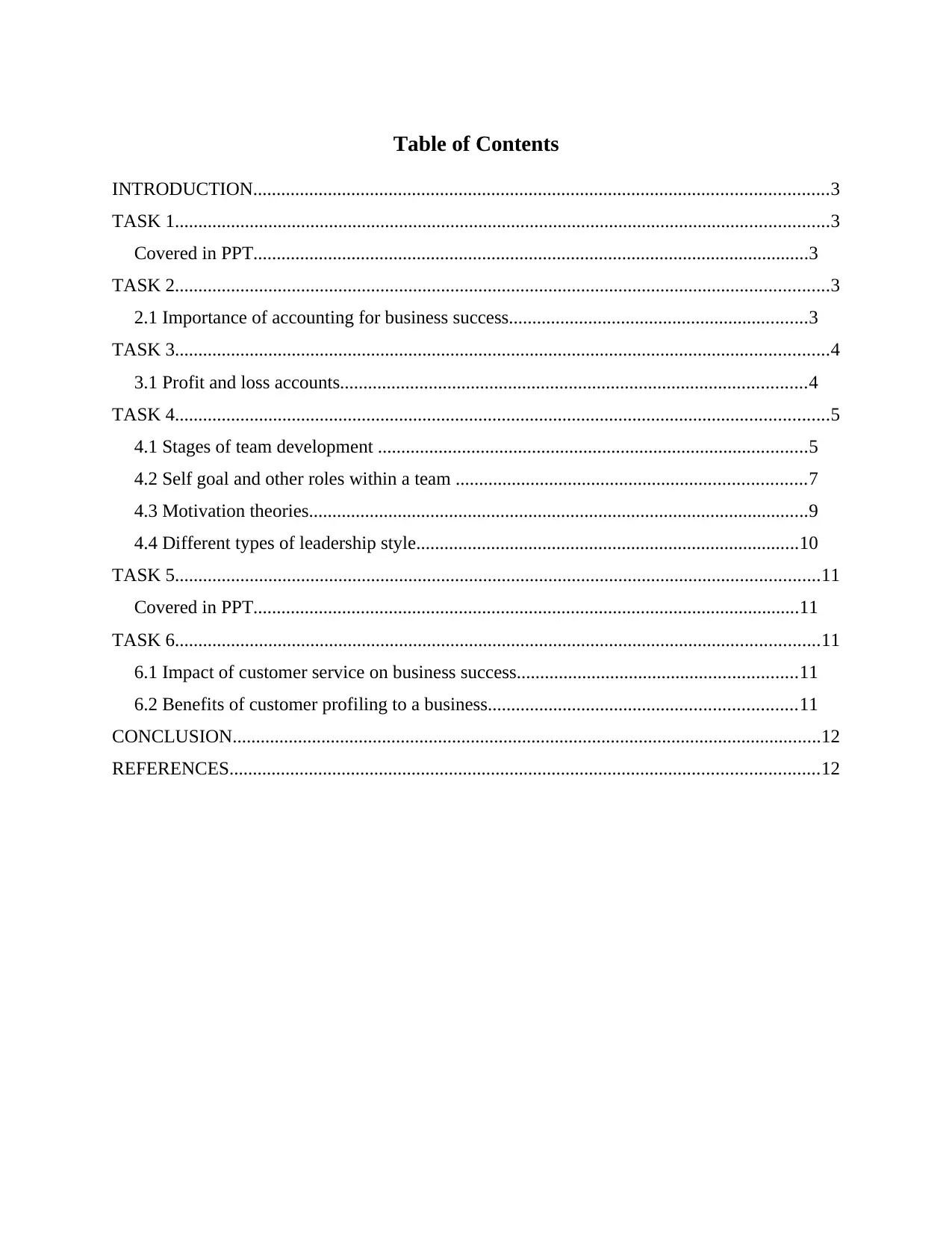
Table of Contents
INTRODUCTION...........................................................................................................................3
TASK 1............................................................................................................................................3
Covered in PPT.......................................................................................................................3
TASK 2............................................................................................................................................3
2.1 Importance of accounting for business success................................................................3
TASK 3............................................................................................................................................4
3.1 Profit and loss accounts....................................................................................................4
TASK 4............................................................................................................................................5
4.1 Stages of team development ............................................................................................5
4.2 Self goal and other roles within a team ...........................................................................7
4.3 Motivation theories...........................................................................................................9
4.4 Different types of leadership style..................................................................................10
TASK 5..........................................................................................................................................11
Covered in PPT.....................................................................................................................11
TASK 6..........................................................................................................................................11
6.1 Impact of customer service on business success............................................................11
6.2 Benefits of customer profiling to a business..................................................................11
CONCLUSION..............................................................................................................................12
REFERENCES..............................................................................................................................12
INTRODUCTION...........................................................................................................................3
TASK 1............................................................................................................................................3
Covered in PPT.......................................................................................................................3
TASK 2............................................................................................................................................3
2.1 Importance of accounting for business success................................................................3
TASK 3............................................................................................................................................4
3.1 Profit and loss accounts....................................................................................................4
TASK 4............................................................................................................................................5
4.1 Stages of team development ............................................................................................5
4.2 Self goal and other roles within a team ...........................................................................7
4.3 Motivation theories...........................................................................................................9
4.4 Different types of leadership style..................................................................................10
TASK 5..........................................................................................................................................11
Covered in PPT.....................................................................................................................11
TASK 6..........................................................................................................................................11
6.1 Impact of customer service on business success............................................................11
6.2 Benefits of customer profiling to a business..................................................................11
CONCLUSION..............................................................................................................................12
REFERENCES..............................................................................................................................12
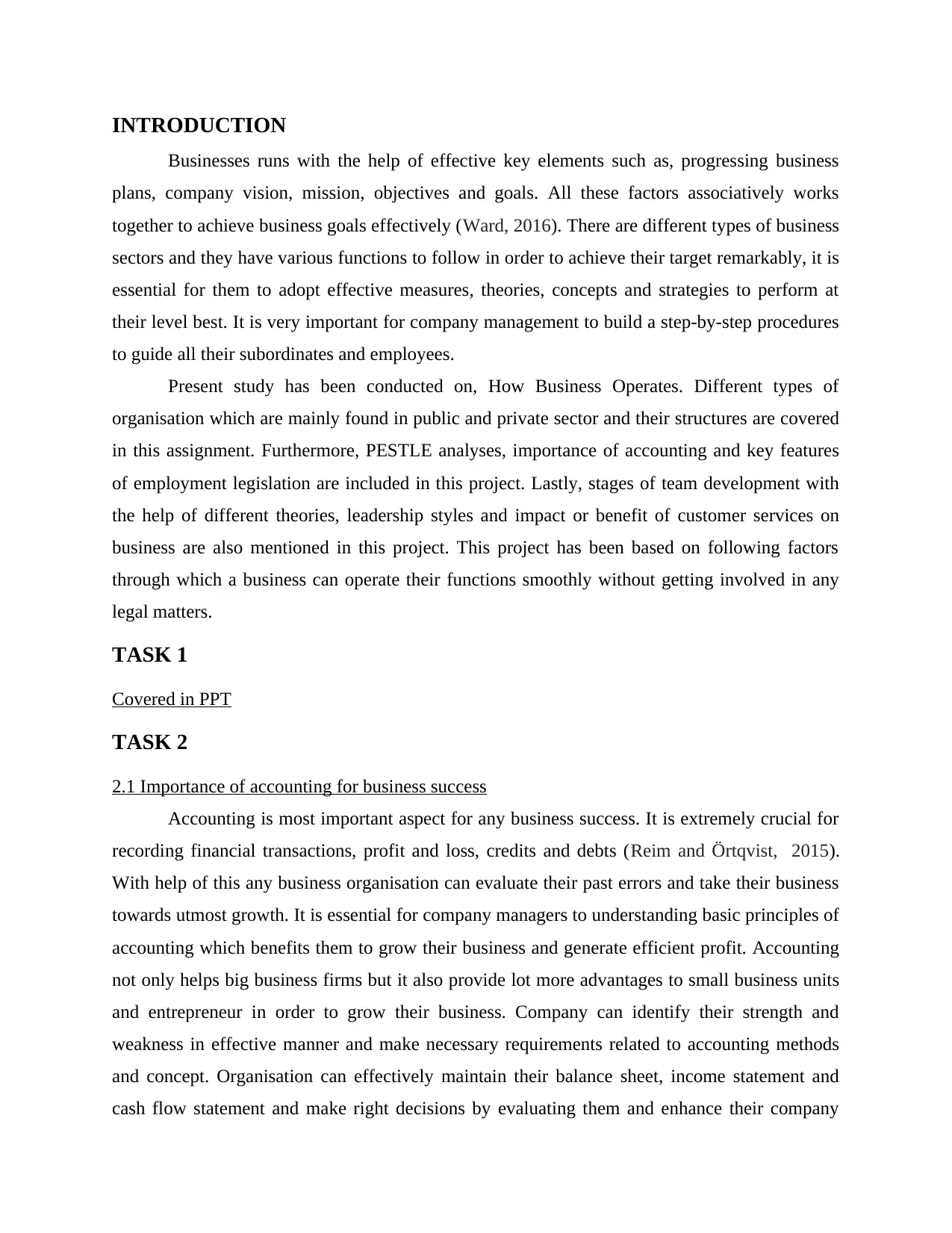
INTRODUCTION
Businesses runs with the help of effective key elements such as, progressing business
plans, company vision, mission, objectives and goals. All these factors associatively works
together to achieve business goals effectively (Ward, 2016). There are different types of business
sectors and they have various functions to follow in order to achieve their target remarkably, it is
essential for them to adopt effective measures, theories, concepts and strategies to perform at
their level best. It is very important for company management to build a step-by-step procedures
to guide all their subordinates and employees.
Present study has been conducted on, How Business Operates. Different types of
organisation which are mainly found in public and private sector and their structures are covered
in this assignment. Furthermore, PESTLE analyses, importance of accounting and key features
of employment legislation are included in this project. Lastly, stages of team development with
the help of different theories, leadership styles and impact or benefit of customer services on
business are also mentioned in this project. This project has been based on following factors
through which a business can operate their functions smoothly without getting involved in any
legal matters.
TASK 1
Covered in PPT
TASK 2
2.1 Importance of accounting for business success
Accounting is most important aspect for any business success. It is extremely crucial for
recording financial transactions, profit and loss, credits and debts (Reim and Örtqvist, 2015).
With help of this any business organisation can evaluate their past errors and take their business
towards utmost growth. It is essential for company managers to understanding basic principles of
accounting which benefits them to grow their business and generate efficient profit. Accounting
not only helps big business firms but it also provide lot more advantages to small business units
and entrepreneur in order to grow their business. Company can identify their strength and
weakness in effective manner and make necessary requirements related to accounting methods
and concept. Organisation can effectively maintain their balance sheet, income statement and
cash flow statement and make right decisions by evaluating them and enhance their company
Businesses runs with the help of effective key elements such as, progressing business
plans, company vision, mission, objectives and goals. All these factors associatively works
together to achieve business goals effectively (Ward, 2016). There are different types of business
sectors and they have various functions to follow in order to achieve their target remarkably, it is
essential for them to adopt effective measures, theories, concepts and strategies to perform at
their level best. It is very important for company management to build a step-by-step procedures
to guide all their subordinates and employees.
Present study has been conducted on, How Business Operates. Different types of
organisation which are mainly found in public and private sector and their structures are covered
in this assignment. Furthermore, PESTLE analyses, importance of accounting and key features
of employment legislation are included in this project. Lastly, stages of team development with
the help of different theories, leadership styles and impact or benefit of customer services on
business are also mentioned in this project. This project has been based on following factors
through which a business can operate their functions smoothly without getting involved in any
legal matters.
TASK 1
Covered in PPT
TASK 2
2.1 Importance of accounting for business success
Accounting is most important aspect for any business success. It is extremely crucial for
recording financial transactions, profit and loss, credits and debts (Reim and Örtqvist, 2015).
With help of this any business organisation can evaluate their past errors and take their business
towards utmost growth. It is essential for company managers to understanding basic principles of
accounting which benefits them to grow their business and generate efficient profit. Accounting
not only helps big business firms but it also provide lot more advantages to small business units
and entrepreneur in order to grow their business. Company can identify their strength and
weakness in effective manner and make necessary requirements related to accounting methods
and concept. Organisation can effectively maintain their balance sheet, income statement and
cash flow statement and make right decisions by evaluating them and enhance their company
⊘ This is a preview!⊘
Do you want full access?
Subscribe today to unlock all pages.

Trusted by 1+ million students worldwide
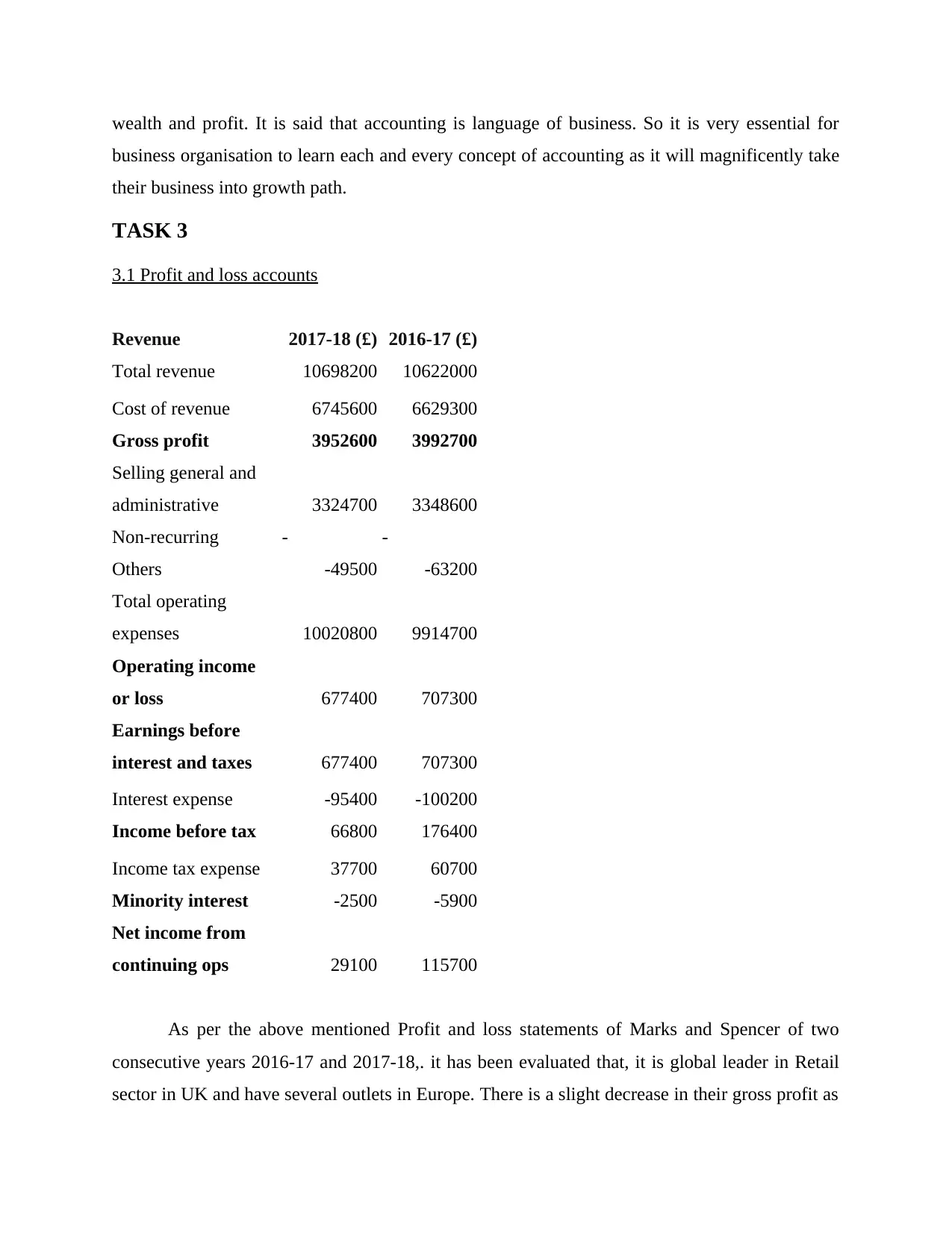
wealth and profit. It is said that accounting is language of business. So it is very essential for
business organisation to learn each and every concept of accounting as it will magnificently take
their business into growth path.
TASK 3
3.1 Profit and loss accounts
Revenue 2017-18 (£) 2016-17 (£)
Total revenue 10698200 10622000
Cost of revenue 6745600 6629300
Gross profit 3952600 3992700
Selling general and
administrative 3324700 3348600
Non-recurring - -
Others -49500 -63200
Total operating
expenses 10020800 9914700
Operating income
or loss 677400 707300
Earnings before
interest and taxes 677400 707300
Interest expense -95400 -100200
Income before tax 66800 176400
Income tax expense 37700 60700
Minority interest -2500 -5900
Net income from
continuing ops 29100 115700
As per the above mentioned Profit and loss statements of Marks and Spencer of two
consecutive years 2016-17 and 2017-18,. it has been evaluated that, it is global leader in Retail
sector in UK and have several outlets in Europe. There is a slight decrease in their gross profit as
business organisation to learn each and every concept of accounting as it will magnificently take
their business into growth path.
TASK 3
3.1 Profit and loss accounts
Revenue 2017-18 (£) 2016-17 (£)
Total revenue 10698200 10622000
Cost of revenue 6745600 6629300
Gross profit 3952600 3992700
Selling general and
administrative 3324700 3348600
Non-recurring - -
Others -49500 -63200
Total operating
expenses 10020800 9914700
Operating income
or loss 677400 707300
Earnings before
interest and taxes 677400 707300
Interest expense -95400 -100200
Income before tax 66800 176400
Income tax expense 37700 60700
Minority interest -2500 -5900
Net income from
continuing ops 29100 115700
As per the above mentioned Profit and loss statements of Marks and Spencer of two
consecutive years 2016-17 and 2017-18,. it has been evaluated that, it is global leader in Retail
sector in UK and have several outlets in Europe. There is a slight decrease in their gross profit as
Paraphrase This Document
Need a fresh take? Get an instant paraphrase of this document with our AI Paraphraser
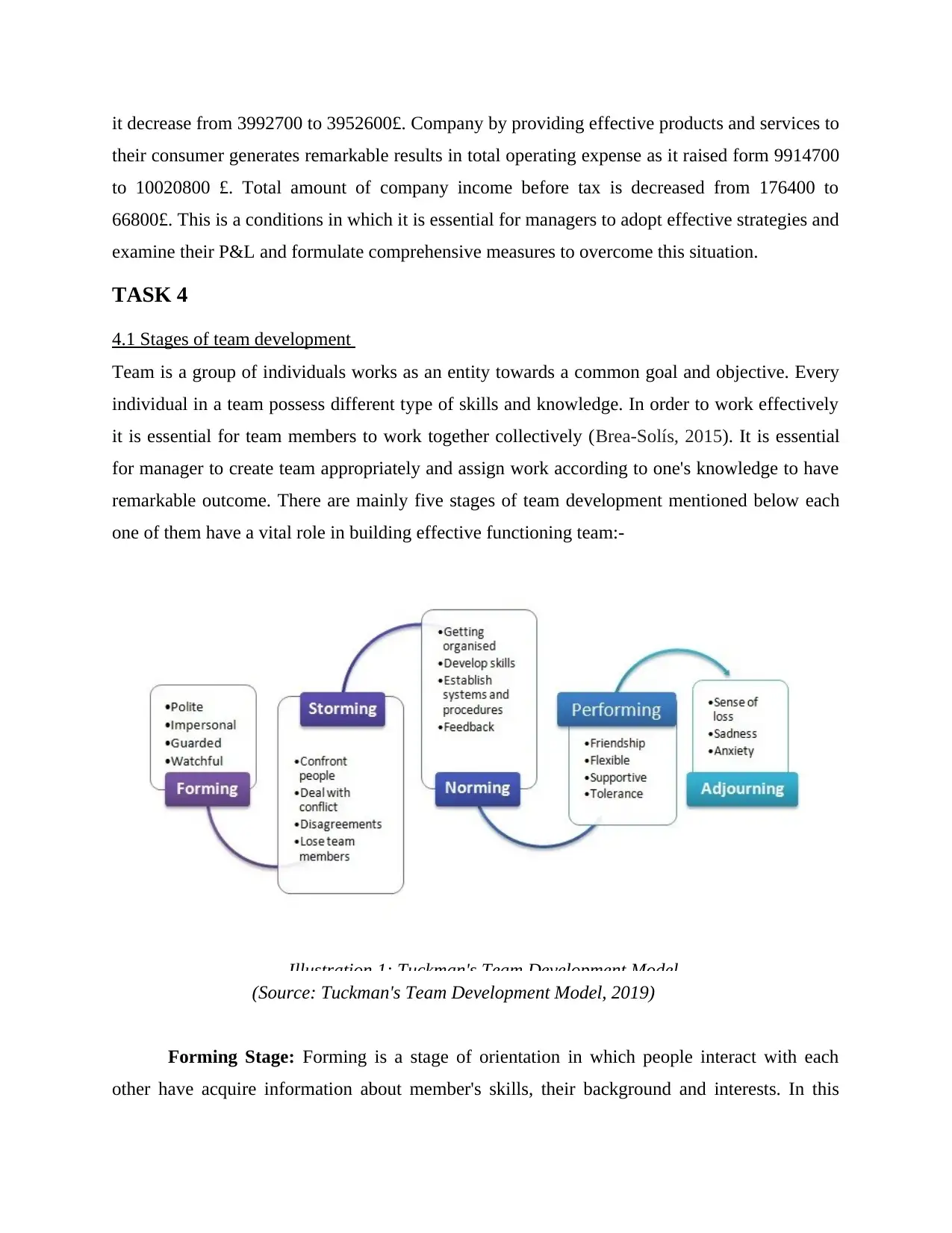
it decrease from 3992700 to 3952600£. Company by providing effective products and services to
their consumer generates remarkable results in total operating expense as it raised form 9914700
to 10020800 £. Total amount of company income before tax is decreased from 176400 to
66800£. This is a conditions in which it is essential for managers to adopt effective strategies and
examine their P&L and formulate comprehensive measures to overcome this situation.
TASK 4
4.1 Stages of team development
Team is a group of individuals works as an entity towards a common goal and objective. Every
individual in a team possess different type of skills and knowledge. In order to work effectively
it is essential for team members to work together collectively (Brea‐Solís, 2015). It is essential
for manager to create team appropriately and assign work according to one's knowledge to have
remarkable outcome. There are mainly five stages of team development mentioned below each
one of them have a vital role in building effective functioning team:-
(Source: Tuckman's Team Development Model, 2019)
Forming Stage: Forming is a stage of orientation in which people interact with each
other have acquire information about member's skills, their background and interests. In this
Illustration 1: Tuckman's Team Development Model
their consumer generates remarkable results in total operating expense as it raised form 9914700
to 10020800 £. Total amount of company income before tax is decreased from 176400 to
66800£. This is a conditions in which it is essential for managers to adopt effective strategies and
examine their P&L and formulate comprehensive measures to overcome this situation.
TASK 4
4.1 Stages of team development
Team is a group of individuals works as an entity towards a common goal and objective. Every
individual in a team possess different type of skills and knowledge. In order to work effectively
it is essential for team members to work together collectively (Brea‐Solís, 2015). It is essential
for manager to create team appropriately and assign work according to one's knowledge to have
remarkable outcome. There are mainly five stages of team development mentioned below each
one of them have a vital role in building effective functioning team:-
(Source: Tuckman's Team Development Model, 2019)
Forming Stage: Forming is a stage of orientation in which people interact with each
other have acquire information about member's skills, their background and interests. In this
Illustration 1: Tuckman's Team Development Model
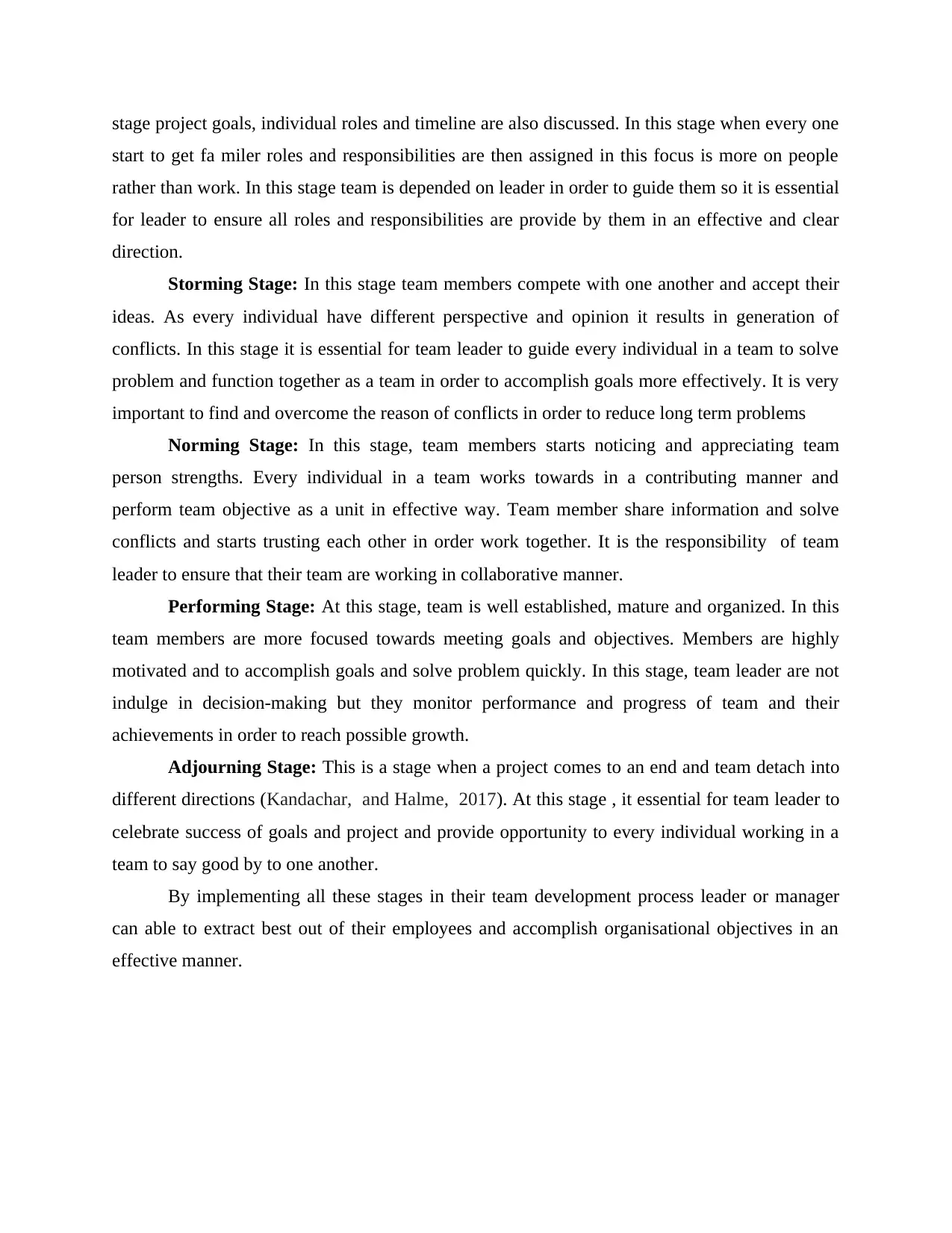
stage project goals, individual roles and timeline are also discussed. In this stage when every one
start to get fa miler roles and responsibilities are then assigned in this focus is more on people
rather than work. In this stage team is depended on leader in order to guide them so it is essential
for leader to ensure all roles and responsibilities are provide by them in an effective and clear
direction.
Storming Stage: In this stage team members compete with one another and accept their
ideas. As every individual have different perspective and opinion it results in generation of
conflicts. In this stage it is essential for team leader to guide every individual in a team to solve
problem and function together as a team in order to accomplish goals more effectively. It is very
important to find and overcome the reason of conflicts in order to reduce long term problems
Norming Stage: In this stage, team members starts noticing and appreciating team
person strengths. Every individual in a team works towards in a contributing manner and
perform team objective as a unit in effective way. Team member share information and solve
conflicts and starts trusting each other in order work together. It is the responsibility of team
leader to ensure that their team are working in collaborative manner.
Performing Stage: At this stage, team is well established, mature and organized. In this
team members are more focused towards meeting goals and objectives. Members are highly
motivated and to accomplish goals and solve problem quickly. In this stage, team leader are not
indulge in decision-making but they monitor performance and progress of team and their
achievements in order to reach possible growth.
Adjourning Stage: This is a stage when a project comes to an end and team detach into
different directions (Kandachar, and Halme, 2017). At this stage , it essential for team leader to
celebrate success of goals and project and provide opportunity to every individual working in a
team to say good by to one another.
By implementing all these stages in their team development process leader or manager
can able to extract best out of their employees and accomplish organisational objectives in an
effective manner.
start to get fa miler roles and responsibilities are then assigned in this focus is more on people
rather than work. In this stage team is depended on leader in order to guide them so it is essential
for leader to ensure all roles and responsibilities are provide by them in an effective and clear
direction.
Storming Stage: In this stage team members compete with one another and accept their
ideas. As every individual have different perspective and opinion it results in generation of
conflicts. In this stage it is essential for team leader to guide every individual in a team to solve
problem and function together as a team in order to accomplish goals more effectively. It is very
important to find and overcome the reason of conflicts in order to reduce long term problems
Norming Stage: In this stage, team members starts noticing and appreciating team
person strengths. Every individual in a team works towards in a contributing manner and
perform team objective as a unit in effective way. Team member share information and solve
conflicts and starts trusting each other in order work together. It is the responsibility of team
leader to ensure that their team are working in collaborative manner.
Performing Stage: At this stage, team is well established, mature and organized. In this
team members are more focused towards meeting goals and objectives. Members are highly
motivated and to accomplish goals and solve problem quickly. In this stage, team leader are not
indulge in decision-making but they monitor performance and progress of team and their
achievements in order to reach possible growth.
Adjourning Stage: This is a stage when a project comes to an end and team detach into
different directions (Kandachar, and Halme, 2017). At this stage , it essential for team leader to
celebrate success of goals and project and provide opportunity to every individual working in a
team to say good by to one another.
By implementing all these stages in their team development process leader or manager
can able to extract best out of their employees and accomplish organisational objectives in an
effective manner.
⊘ This is a preview!⊘
Do you want full access?
Subscribe today to unlock all pages.

Trusted by 1+ million students worldwide
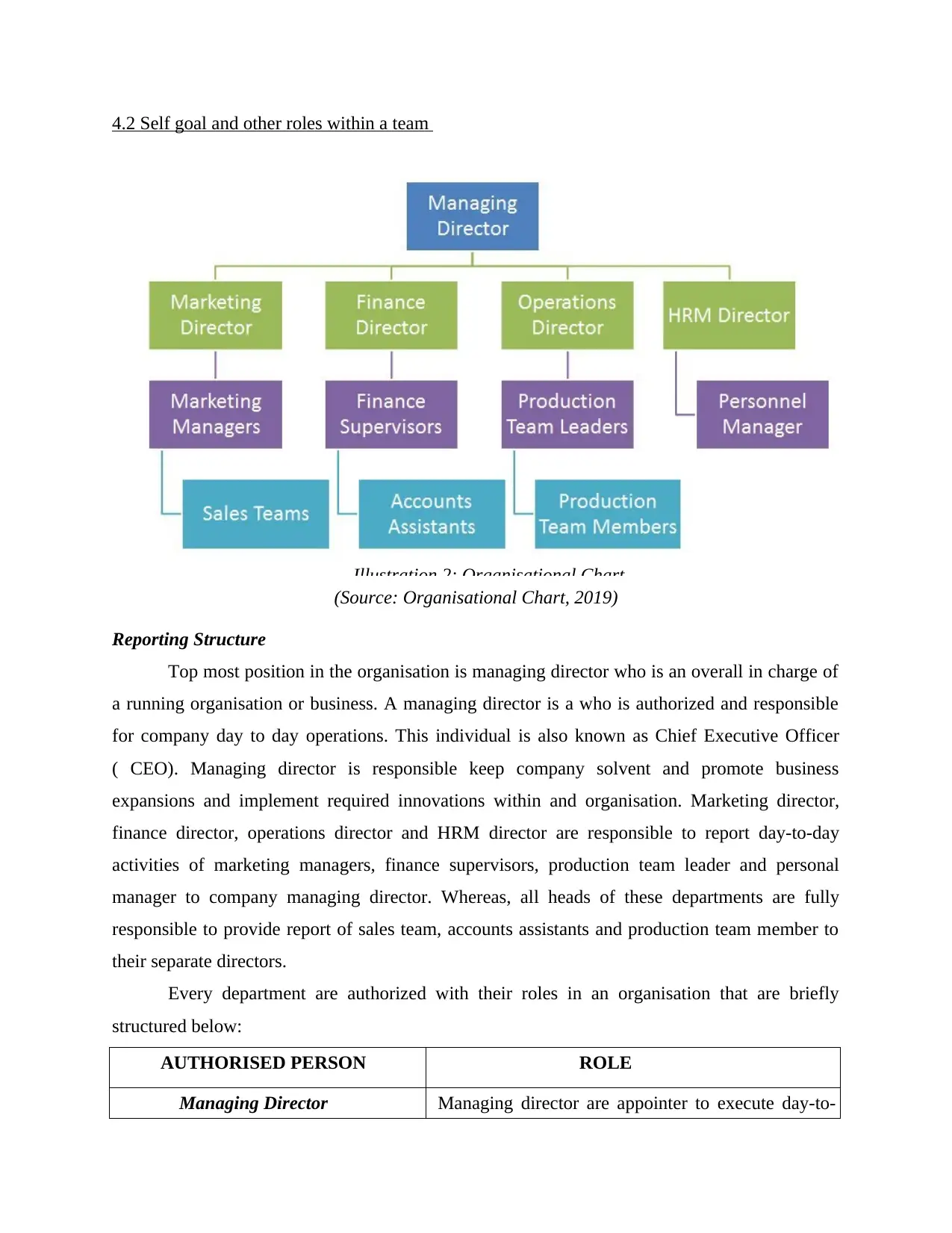
4.2 Self goal and other roles within a team
(Source: Organisational Chart, 2019)
Reporting Structure
Top most position in the organisation is managing director who is an overall in charge of
a running organisation or business. A managing director is a who is authorized and responsible
for company day to day operations. This individual is also known as Chief Executive Officer
( CEO). Managing director is responsible keep company solvent and promote business
expansions and implement required innovations within and organisation. Marketing director,
finance director, operations director and HRM director are responsible to report day-to-day
activities of marketing managers, finance supervisors, production team leader and personal
manager to company managing director. Whereas, all heads of these departments are fully
responsible to provide report of sales team, accounts assistants and production team member to
their separate directors.
Every department are authorized with their roles in an organisation that are briefly
structured below:
AUTHORISED PERSON ROLE
Managing Director Managing director are appointer to execute day-to-
Illustration 2: Organisational Chart
(Source: Organisational Chart, 2019)
Reporting Structure
Top most position in the organisation is managing director who is an overall in charge of
a running organisation or business. A managing director is a who is authorized and responsible
for company day to day operations. This individual is also known as Chief Executive Officer
( CEO). Managing director is responsible keep company solvent and promote business
expansions and implement required innovations within and organisation. Marketing director,
finance director, operations director and HRM director are responsible to report day-to-day
activities of marketing managers, finance supervisors, production team leader and personal
manager to company managing director. Whereas, all heads of these departments are fully
responsible to provide report of sales team, accounts assistants and production team member to
their separate directors.
Every department are authorized with their roles in an organisation that are briefly
structured below:
AUTHORISED PERSON ROLE
Managing Director Managing director are appointer to execute day-to-
Illustration 2: Organisational Chart
Paraphrase This Document
Need a fresh take? Get an instant paraphrase of this document with our AI Paraphraser
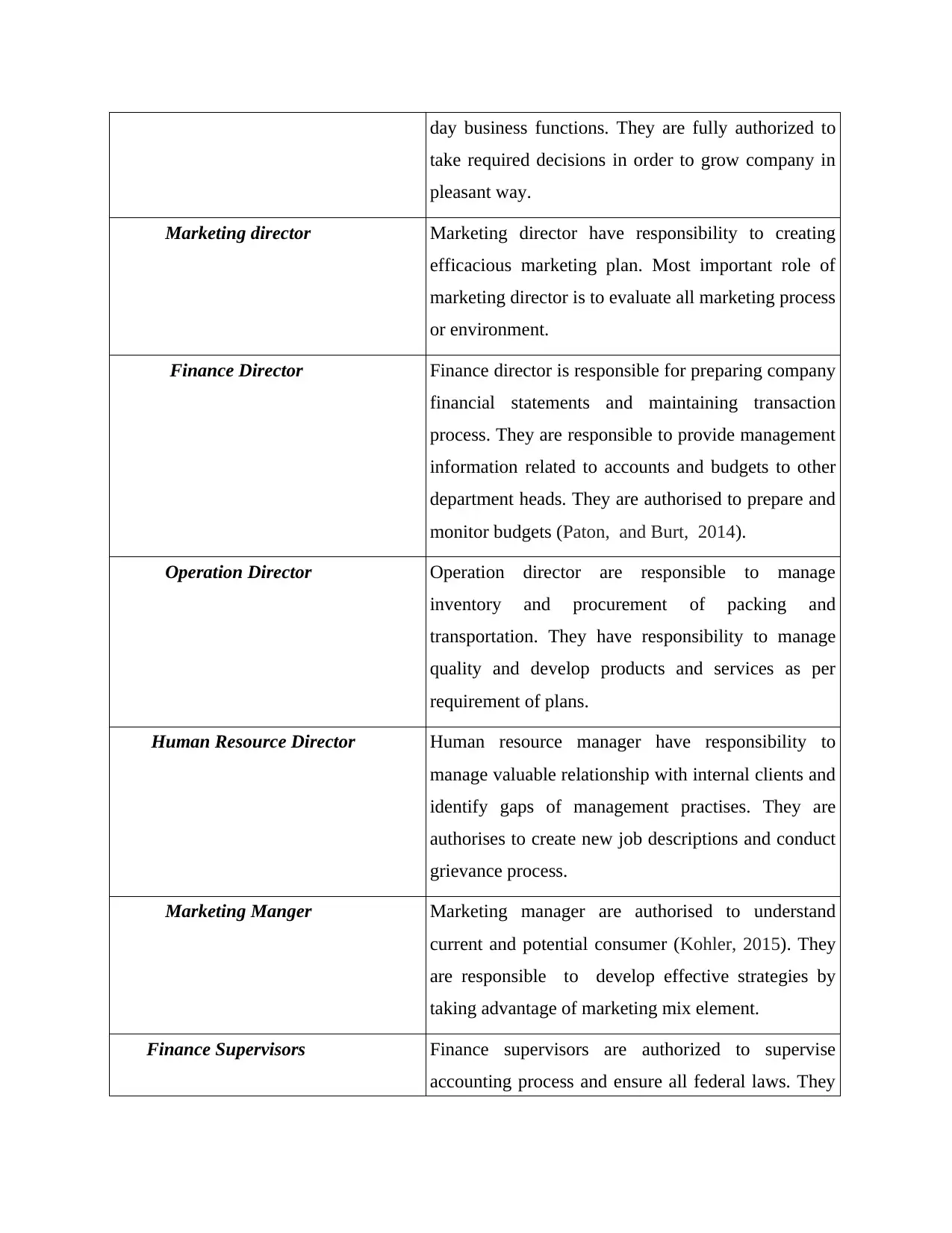
day business functions. They are fully authorized to
take required decisions in order to grow company in
pleasant way.
Marketing director Marketing director have responsibility to creating
efficacious marketing plan. Most important role of
marketing director is to evaluate all marketing process
or environment.
Finance Director Finance director is responsible for preparing company
financial statements and maintaining transaction
process. They are responsible to provide management
information related to accounts and budgets to other
department heads. They are authorised to prepare and
monitor budgets (Paton, and Burt, 2014).
Operation Director Operation director are responsible to manage
inventory and procurement of packing and
transportation. They have responsibility to manage
quality and develop products and services as per
requirement of plans.
Human Resource Director Human resource manager have responsibility to
manage valuable relationship with internal clients and
identify gaps of management practises. They are
authorises to create new job descriptions and conduct
grievance process.
Marketing Manger Marketing manager are authorised to understand
current and potential consumer (Kohler, 2015). They
are responsible to develop effective strategies by
taking advantage of marketing mix element.
Finance Supervisors Finance supervisors are authorized to supervise
accounting process and ensure all federal laws. They
take required decisions in order to grow company in
pleasant way.
Marketing director Marketing director have responsibility to creating
efficacious marketing plan. Most important role of
marketing director is to evaluate all marketing process
or environment.
Finance Director Finance director is responsible for preparing company
financial statements and maintaining transaction
process. They are responsible to provide management
information related to accounts and budgets to other
department heads. They are authorised to prepare and
monitor budgets (Paton, and Burt, 2014).
Operation Director Operation director are responsible to manage
inventory and procurement of packing and
transportation. They have responsibility to manage
quality and develop products and services as per
requirement of plans.
Human Resource Director Human resource manager have responsibility to
manage valuable relationship with internal clients and
identify gaps of management practises. They are
authorises to create new job descriptions and conduct
grievance process.
Marketing Manger Marketing manager are authorised to understand
current and potential consumer (Kohler, 2015). They
are responsible to develop effective strategies by
taking advantage of marketing mix element.
Finance Supervisors Finance supervisors are authorized to supervise
accounting process and ensure all federal laws. They
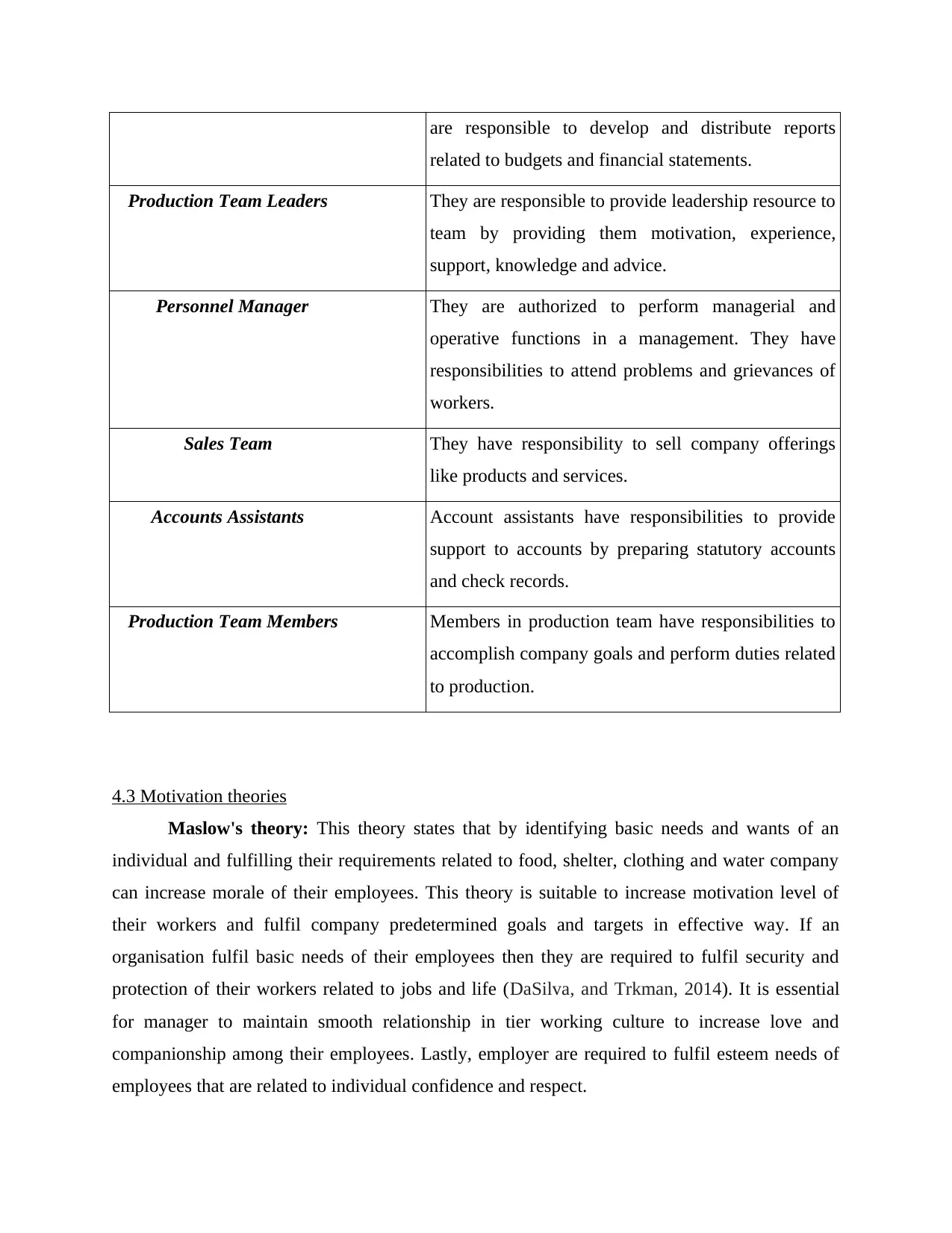
are responsible to develop and distribute reports
related to budgets and financial statements.
Production Team Leaders They are responsible to provide leadership resource to
team by providing them motivation, experience,
support, knowledge and advice.
Personnel Manager They are authorized to perform managerial and
operative functions in a management. They have
responsibilities to attend problems and grievances of
workers.
Sales Team They have responsibility to sell company offerings
like products and services.
Accounts Assistants Account assistants have responsibilities to provide
support to accounts by preparing statutory accounts
and check records.
Production Team Members Members in production team have responsibilities to
accomplish company goals and perform duties related
to production.
4.3 Motivation theories
Maslow's theory: This theory states that by identifying basic needs and wants of an
individual and fulfilling their requirements related to food, shelter, clothing and water company
can increase morale of their employees. This theory is suitable to increase motivation level of
their workers and fulfil company predetermined goals and targets in effective way. If an
organisation fulfil basic needs of their employees then they are required to fulfil security and
protection of their workers related to jobs and life (DaSilva, and Trkman, 2014). It is essential
for manager to maintain smooth relationship in tier working culture to increase love and
companionship among their employees. Lastly, employer are required to fulfil esteem needs of
employees that are related to individual confidence and respect.
related to budgets and financial statements.
Production Team Leaders They are responsible to provide leadership resource to
team by providing them motivation, experience,
support, knowledge and advice.
Personnel Manager They are authorized to perform managerial and
operative functions in a management. They have
responsibilities to attend problems and grievances of
workers.
Sales Team They have responsibility to sell company offerings
like products and services.
Accounts Assistants Account assistants have responsibilities to provide
support to accounts by preparing statutory accounts
and check records.
Production Team Members Members in production team have responsibilities to
accomplish company goals and perform duties related
to production.
4.3 Motivation theories
Maslow's theory: This theory states that by identifying basic needs and wants of an
individual and fulfilling their requirements related to food, shelter, clothing and water company
can increase morale of their employees. This theory is suitable to increase motivation level of
their workers and fulfil company predetermined goals and targets in effective way. If an
organisation fulfil basic needs of their employees then they are required to fulfil security and
protection of their workers related to jobs and life (DaSilva, and Trkman, 2014). It is essential
for manager to maintain smooth relationship in tier working culture to increase love and
companionship among their employees. Lastly, employer are required to fulfil esteem needs of
employees that are related to individual confidence and respect.
⊘ This is a preview!⊘
Do you want full access?
Subscribe today to unlock all pages.

Trusted by 1+ million students worldwide
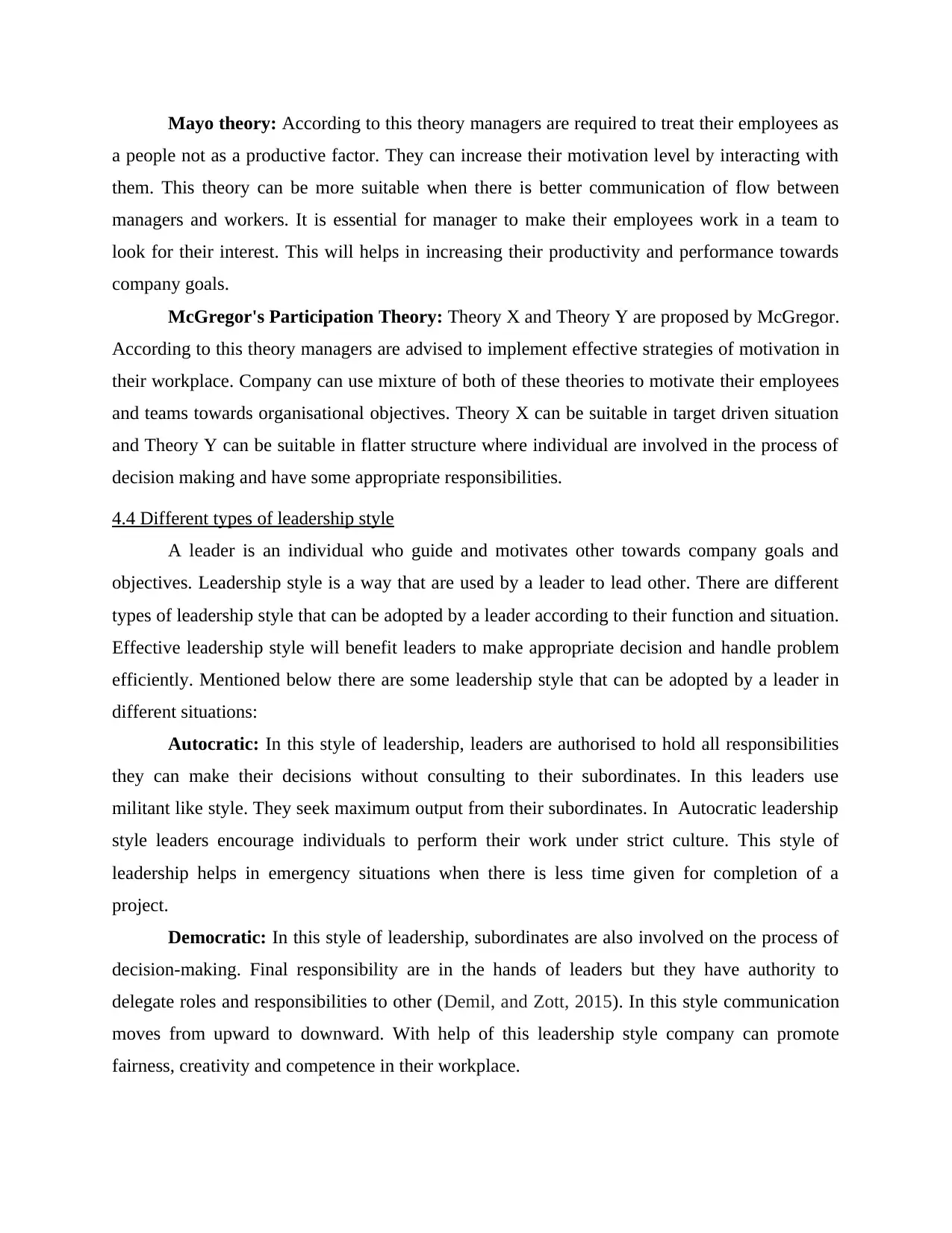
Mayo theory: According to this theory managers are required to treat their employees as
a people not as a productive factor. They can increase their motivation level by interacting with
them. This theory can be more suitable when there is better communication of flow between
managers and workers. It is essential for manager to make their employees work in a team to
look for their interest. This will helps in increasing their productivity and performance towards
company goals.
McGregor's Participation Theory: Theory X and Theory Y are proposed by McGregor.
According to this theory managers are advised to implement effective strategies of motivation in
their workplace. Company can use mixture of both of these theories to motivate their employees
and teams towards organisational objectives. Theory X can be suitable in target driven situation
and Theory Y can be suitable in flatter structure where individual are involved in the process of
decision making and have some appropriate responsibilities.
4.4 Different types of leadership style
A leader is an individual who guide and motivates other towards company goals and
objectives. Leadership style is a way that are used by a leader to lead other. There are different
types of leadership style that can be adopted by a leader according to their function and situation.
Effective leadership style will benefit leaders to make appropriate decision and handle problem
efficiently. Mentioned below there are some leadership style that can be adopted by a leader in
different situations:
Autocratic: In this style of leadership, leaders are authorised to hold all responsibilities
they can make their decisions without consulting to their subordinates. In this leaders use
militant like style. They seek maximum output from their subordinates. In Autocratic leadership
style leaders encourage individuals to perform their work under strict culture. This style of
leadership helps in emergency situations when there is less time given for completion of a
project.
Democratic: In this style of leadership, subordinates are also involved on the process of
decision-making. Final responsibility are in the hands of leaders but they have authority to
delegate roles and responsibilities to other (Demil, and Zott, 2015). In this style communication
moves from upward to downward. With help of this leadership style company can promote
fairness, creativity and competence in their workplace.
a people not as a productive factor. They can increase their motivation level by interacting with
them. This theory can be more suitable when there is better communication of flow between
managers and workers. It is essential for manager to make their employees work in a team to
look for their interest. This will helps in increasing their productivity and performance towards
company goals.
McGregor's Participation Theory: Theory X and Theory Y are proposed by McGregor.
According to this theory managers are advised to implement effective strategies of motivation in
their workplace. Company can use mixture of both of these theories to motivate their employees
and teams towards organisational objectives. Theory X can be suitable in target driven situation
and Theory Y can be suitable in flatter structure where individual are involved in the process of
decision making and have some appropriate responsibilities.
4.4 Different types of leadership style
A leader is an individual who guide and motivates other towards company goals and
objectives. Leadership style is a way that are used by a leader to lead other. There are different
types of leadership style that can be adopted by a leader according to their function and situation.
Effective leadership style will benefit leaders to make appropriate decision and handle problem
efficiently. Mentioned below there are some leadership style that can be adopted by a leader in
different situations:
Autocratic: In this style of leadership, leaders are authorised to hold all responsibilities
they can make their decisions without consulting to their subordinates. In this leaders use
militant like style. They seek maximum output from their subordinates. In Autocratic leadership
style leaders encourage individuals to perform their work under strict culture. This style of
leadership helps in emergency situations when there is less time given for completion of a
project.
Democratic: In this style of leadership, subordinates are also involved on the process of
decision-making. Final responsibility are in the hands of leaders but they have authority to
delegate roles and responsibilities to other (Demil, and Zott, 2015). In this style communication
moves from upward to downward. With help of this leadership style company can promote
fairness, creativity and competence in their workplace.
Paraphrase This Document
Need a fresh take? Get an instant paraphrase of this document with our AI Paraphraser
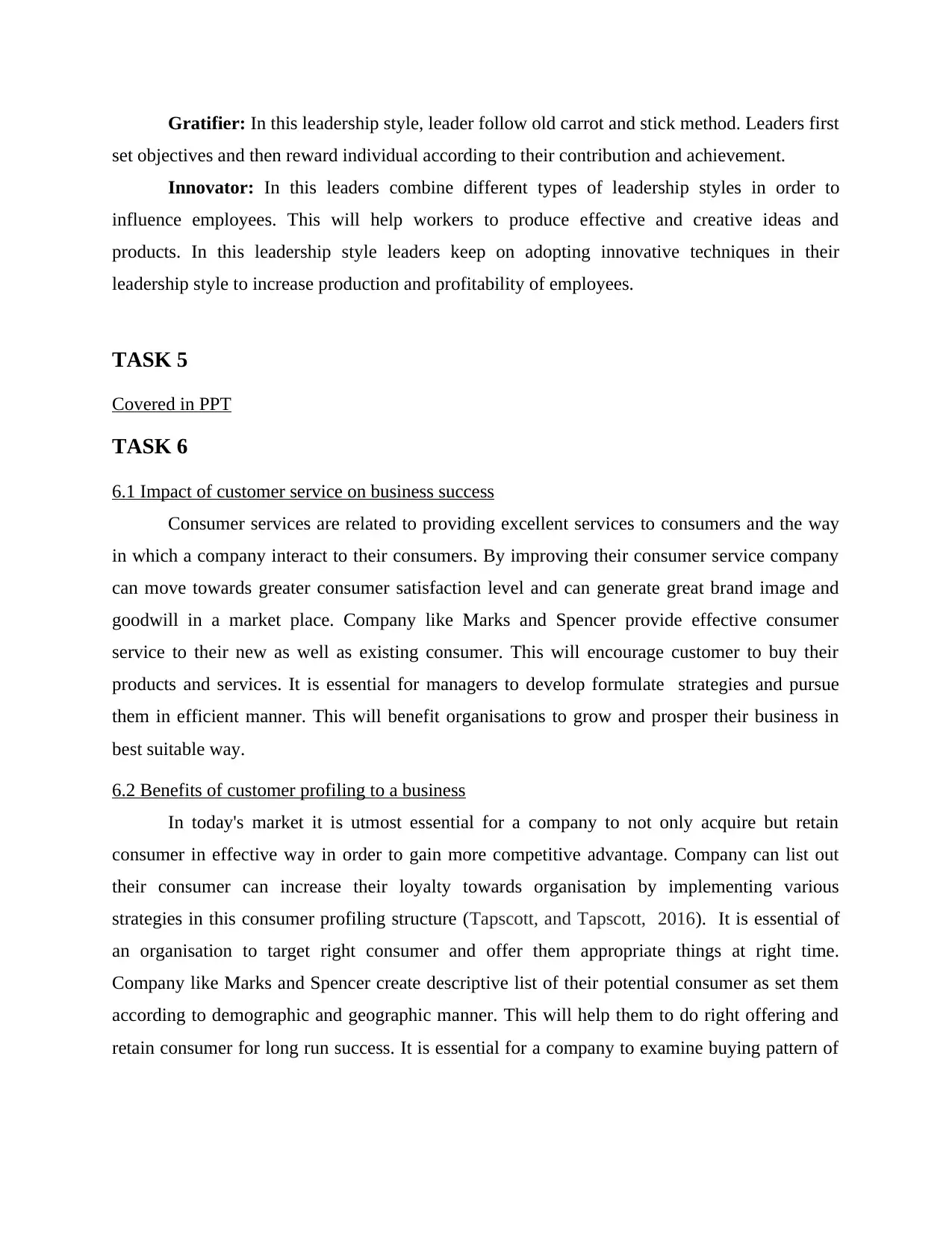
Gratifier: In this leadership style, leader follow old carrot and stick method. Leaders first
set objectives and then reward individual according to their contribution and achievement.
Innovator: In this leaders combine different types of leadership styles in order to
influence employees. This will help workers to produce effective and creative ideas and
products. In this leadership style leaders keep on adopting innovative techniques in their
leadership style to increase production and profitability of employees.
TASK 5
Covered in PPT
TASK 6
6.1 Impact of customer service on business success
Consumer services are related to providing excellent services to consumers and the way
in which a company interact to their consumers. By improving their consumer service company
can move towards greater consumer satisfaction level and can generate great brand image and
goodwill in a market place. Company like Marks and Spencer provide effective consumer
service to their new as well as existing consumer. This will encourage customer to buy their
products and services. It is essential for managers to develop formulate strategies and pursue
them in efficient manner. This will benefit organisations to grow and prosper their business in
best suitable way.
6.2 Benefits of customer profiling to a business
In today's market it is utmost essential for a company to not only acquire but retain
consumer in effective way in order to gain more competitive advantage. Company can list out
their consumer can increase their loyalty towards organisation by implementing various
strategies in this consumer profiling structure (Tapscott, and Tapscott, 2016). It is essential of
an organisation to target right consumer and offer them appropriate things at right time.
Company like Marks and Spencer create descriptive list of their potential consumer as set them
according to demographic and geographic manner. This will help them to do right offering and
retain consumer for long run success. It is essential for a company to examine buying pattern of
set objectives and then reward individual according to their contribution and achievement.
Innovator: In this leaders combine different types of leadership styles in order to
influence employees. This will help workers to produce effective and creative ideas and
products. In this leadership style leaders keep on adopting innovative techniques in their
leadership style to increase production and profitability of employees.
TASK 5
Covered in PPT
TASK 6
6.1 Impact of customer service on business success
Consumer services are related to providing excellent services to consumers and the way
in which a company interact to their consumers. By improving their consumer service company
can move towards greater consumer satisfaction level and can generate great brand image and
goodwill in a market place. Company like Marks and Spencer provide effective consumer
service to their new as well as existing consumer. This will encourage customer to buy their
products and services. It is essential for managers to develop formulate strategies and pursue
them in efficient manner. This will benefit organisations to grow and prosper their business in
best suitable way.
6.2 Benefits of customer profiling to a business
In today's market it is utmost essential for a company to not only acquire but retain
consumer in effective way in order to gain more competitive advantage. Company can list out
their consumer can increase their loyalty towards organisation by implementing various
strategies in this consumer profiling structure (Tapscott, and Tapscott, 2016). It is essential of
an organisation to target right consumer and offer them appropriate things at right time.
Company like Marks and Spencer create descriptive list of their potential consumer as set them
according to demographic and geographic manner. This will help them to do right offering and
retain consumer for long run success. It is essential for a company to examine buying pattern of
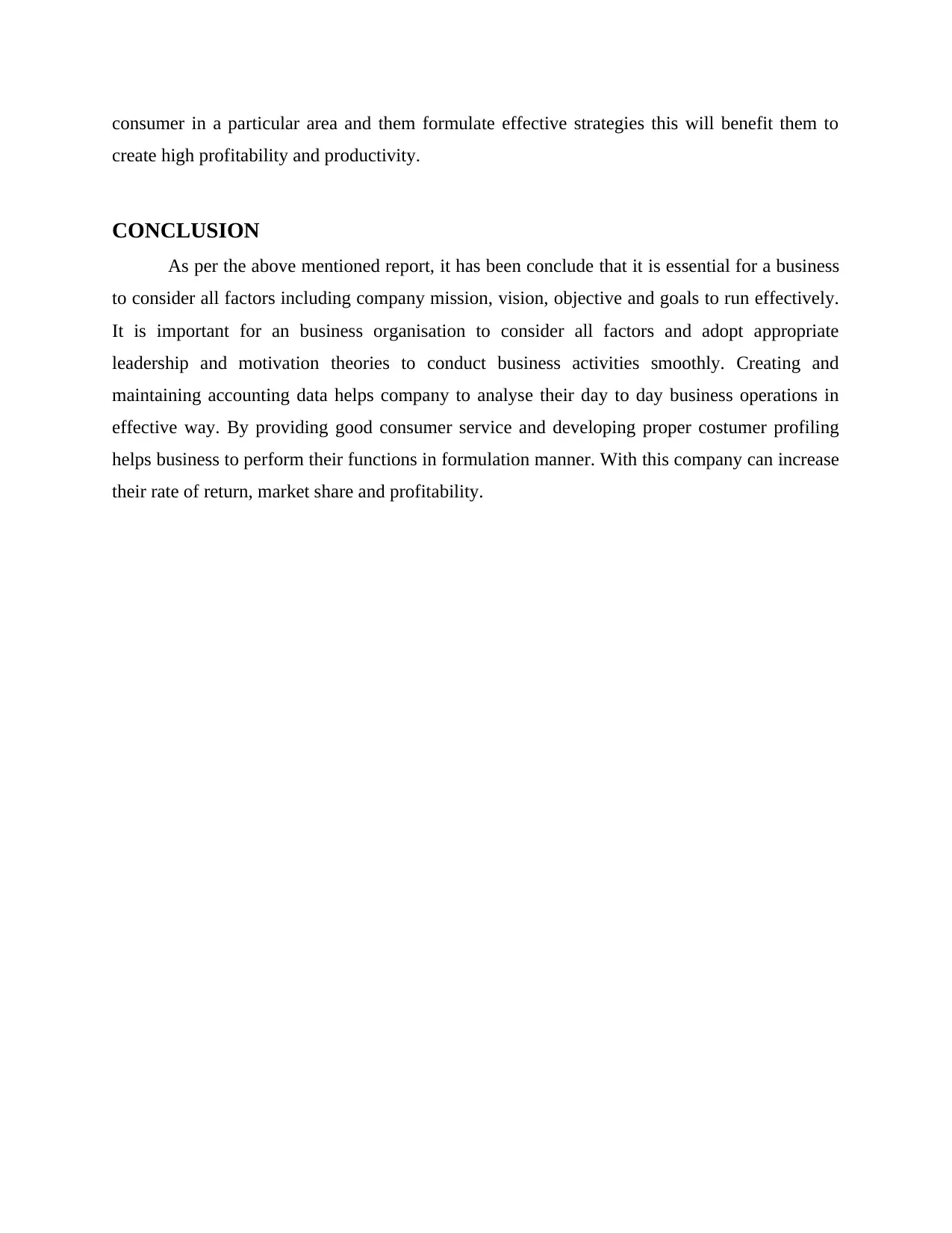
consumer in a particular area and them formulate effective strategies this will benefit them to
create high profitability and productivity.
CONCLUSION
As per the above mentioned report, it has been conclude that it is essential for a business
to consider all factors including company mission, vision, objective and goals to run effectively.
It is important for an business organisation to consider all factors and adopt appropriate
leadership and motivation theories to conduct business activities smoothly. Creating and
maintaining accounting data helps company to analyse their day to day business operations in
effective way. By providing good consumer service and developing proper costumer profiling
helps business to perform their functions in formulation manner. With this company can increase
their rate of return, market share and profitability.
create high profitability and productivity.
CONCLUSION
As per the above mentioned report, it has been conclude that it is essential for a business
to consider all factors including company mission, vision, objective and goals to run effectively.
It is important for an business organisation to consider all factors and adopt appropriate
leadership and motivation theories to conduct business activities smoothly. Creating and
maintaining accounting data helps company to analyse their day to day business operations in
effective way. By providing good consumer service and developing proper costumer profiling
helps business to perform their functions in formulation manner. With this company can increase
their rate of return, market share and profitability.
⊘ This is a preview!⊘
Do you want full access?
Subscribe today to unlock all pages.

Trusted by 1+ million students worldwide
1 out of 13
Related Documents
Your All-in-One AI-Powered Toolkit for Academic Success.
+13062052269
info@desklib.com
Available 24*7 on WhatsApp / Email
![[object Object]](/_next/static/media/star-bottom.7253800d.svg)
Unlock your academic potential
Copyright © 2020–2025 A2Z Services. All Rights Reserved. Developed and managed by ZUCOL.





